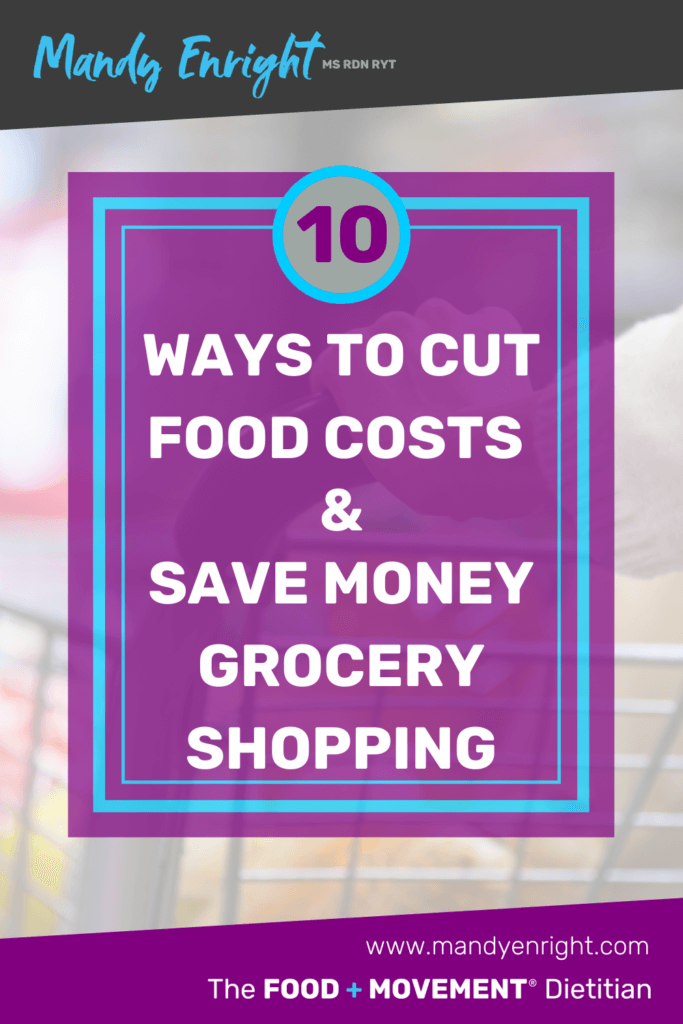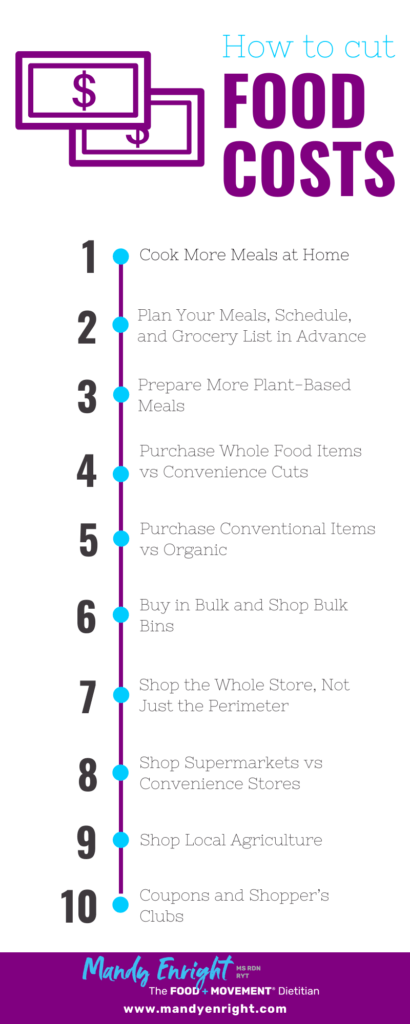10 Ways to Cut Food Costs and Save Money on Grocery Shopping

Oh mid-January. That time of year where the magic of the holidays is long gone. Not only are we dealing with saying bye-bye to the fun vibe of the holidays, but the time has come where those darn credit card bills have come rolling in. Now it’s time to pay for all those awesome gifts you didn’t care what they cost as long as they made the other person happy. Which is why it’s a great time to address NEW-trition Goal for the New Year #3 this week: CUT FOOD COSTS
A common misconception I often hear is that “eating healthy is expensive”. That statement can’t be further from the truth. Those “cheap” meals and deals can often cost you and your health in the long run. If you’re looking to cut food costs, follow these tips that will reduce your food spend without sacrificing your favorites.
New-trition Goals for the New Year:
#3: CUT FOOD COSTS

COOK AT HOME
Sound familiar? There’s a reason I designated Cook More at Home NEW-trition Goal #1 this year. It all stems back to having more control over your food and your spending. One of the biggest reasons people feel eating healthy can be expensive is because dining out is in fact expensive. Compare the cost of that $11 salad you’re buying everyday for lunch versus making your own salad at home to bring to work. I can assure you that you’re not spending $55 in ingredients to make a week worth of salads. Cook more meals at home and your wallet and waistline will thank you!
MEAL PLANNING/PREPPING
Last week I got into the nitty-gritty of meal planning and prepping. This is because planning helps cut costs while food shopping to prevent overbuying. Having a plan also eliminates food waste, which is essentially throwing money in the trash. If you need a refresher on how to get started with meal planning and prepping, check out last week’s post.
MORE PLANT-BASED MEALS
The math is simple. Animal proteins cost more than plant-based foods. Take note next time you go food shopping. The more plant-based meals you can make, the more you will save. Even doing one #MeatlessMonday a week can make a difference in your food spend. Check out some plant-based forms of protein including beans, seeds, jackfruit, soy, tofu, tempeh, and seitan. Need some inspiration getting started with more plant-based meals? Check out my Recipes page or Meatless Monday for lots of inspiration!
RELATED: BITCHIN’ BLACK BEAN BURGER
DIY VS CONVENIENCE CUTS
Purchasing food items intact, such as whole raw vegetables, is going to be significantly less expensive than purchasing convenience cuts. With convenience cuts, you’re paying for someone else to do the work for you of cleaning, cutting, and packing up the food. Taking a few moments to DIY when it comes to washing and prepping veggies can significantly add up to more money in your bank account. However, the caveat I tell a lot of my clients is that if the only barrier to you eating more fruits and veggies is the effort of washing and cutting your own items, then perhaps it’s more worthwhile to you to buy the convenience cuts to help cut down on food waste.
Conventional vs Organic Items
Another factor that leads to the “eating healthy is expensive” perception is that people think that eating healthy means everything must be purchased organic. Yes, organic is going to be a few more bucks compared to its conventional counterpart due to the production guidelines that must be followed in order for food to be labeled “organic”. Does it make it any nutritionally superior? Absolutely not. Conventional produce is as equally nutritious as organic foods. All organic means is that chemical pesticides are not used during production of produce, and animals are served certain diets and not exposed to hormones/antibiotics. If you truly feel strongly about wanting to purchase organic produce, consider purchasing conventional produce that does not involve eating the external skin (such as oranges, bananas, and melons). Get more info on organic labeling standards from the USDA.
BUY IN BULK
This recommendation takes two meanings. Bulk shopping, such as purchasing large items at your local Costco or BJs, will have a lower cost per unit. But sometimes you just don’t need 24 boxes of chicken broth.
Another way to buy in bulk is shop the bulk bins at your local market. When you purchase items from the bulk bins, you have more control over how much you’re purchasing because you measure the amount. Since price is based on weight, if you don’t need a lot of a certain ingredient, you can buy the amount needed and not worry about extras getting lost in the depths of your pantry. Plus, you’re not paying for packaging, which also cuts back on cost.
RELATED: BULKING UP
SHOP THE WHOLE STORE, NOT JUST THE PERIMETER
One of my least favorite pieces of shopping advice people receive is to “only shop the perimeter of the store”. This is bad advice. The center aisles of the supermarket contains high fiber foods like legumes, whole grains, nuts, and seeds. Those bulk bins I mentioned above are found in the center aisles. The freezer section has fruits and veggies that are frozen at their peak point so they are even more nutritious than their fresh counterparts. Oh, and did I mention those frozen items are cost-effective convenience cut options? Even canned items are beneficial, so don’t dismiss those canned foods so quickly.
RELATED: THE PRO BOWL
SUPERMARKETS VS CONVENIENCE STORES
Remember this rule of thumb: the bigger the store, the bigger the savings. If you shop for groceries at local bodegas, convenience stores, and drug stores, you will pay more money. The selectin is lower so they will charge you more for the sake of being “convenient” to you. Supermarkets buy items at wholesale cost and in bulk, so they can charge less money for items. Keep in mind, specialty grocery stores can be more costly than larger chain grocery stores. There’s a reason Whole Foods has earned the nickname “Whole Paycheck”.
SHOP LOCAL AGRICULTURE
Have local farm markets nearby? How about local dairy farms, fishermen, or ranches? The closer you are to the source of origin, the less you will pay. Items produced locally don’t have to travel far, may not involve packaging, and are often sold at cost. Check out your local farm markets or consider taking advantage of joining a CSA to get fresh produce on a weekly basis at cost. Joining a community garden is another way to save money on produce.
COUPONS AND SHOPPER’S CLUBS
Here’s something you may not know about me: I LOVE coupons! For years, the only reason I paid for a Sunday subscription to my local newspaper was to get the coupons. My favorite thing about grocery shopping is to see how much money I save in coupons. Taking advantage of shopper’s club savings is another way I get excited to save. Just be careful – sometimes we can buy unneeded items simply because “I have a coupon for it”. To reduce the excuse of not using coupons, invest in a coupon organizer to keep in your purse or car at all times. This is the one I personally use and it’s fabulous!
Does eating healthy still sound expensive? I hope not. Follow these tips to cut food costs, and you and your Significant Other can treat yourselves to a nice meal at a restaurant every so often with the money you will save. Or maybe even enjoy several meals out on a vacation you earned with the money saved from cooking more at home, planning meals, and cutting back on food spending.
HOW DO YOU CUT FOOD COSTS?
WHAT ARE SOME OF YOUR FAVORITE FOOD COST-SAVING TIPS?
SHARE HOW YOU CUT FOOD COSTS BY TAGGING ME (@mandyenrightRD) ON SOCIAL MEDIA AND USING #FOODANDMOVEMENT
 DISCLAIMER: In the spirit of full disclosure, I am a participant in the Amazon Services LLC Associates Program, an affiliate advertising program designed to provide a means for me to earn fees by linking to Amazon.com and affiliated sites. Please refer to my full Disclosure statement.
DISCLAIMER: In the spirit of full disclosure, I am a participant in the Amazon Services LLC Associates Program, an affiliate advertising program designed to provide a means for me to earn fees by linking to Amazon.com and affiliated sites. Please refer to my full Disclosure statement.



[…] Related: New-trition Goals For The New Year #3: Cut Food Costs […]
[…] CHECK OUT MY TIPS FOR CUTTING FOOD COSTS […]